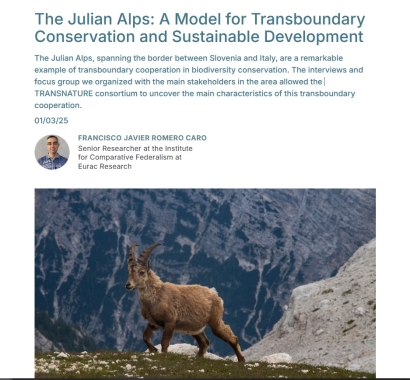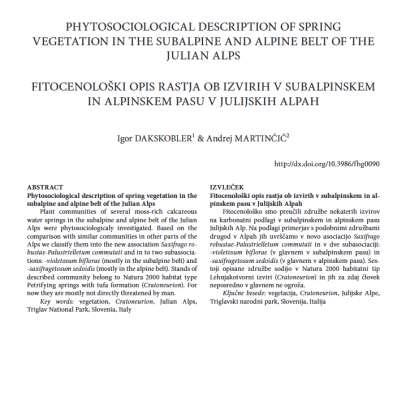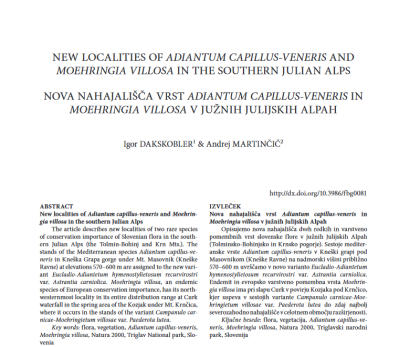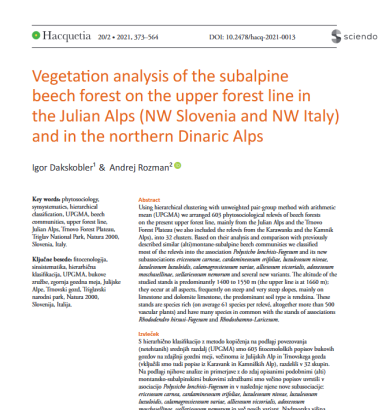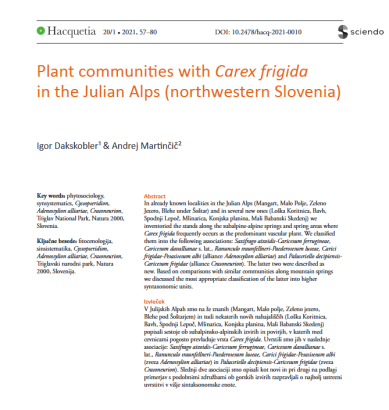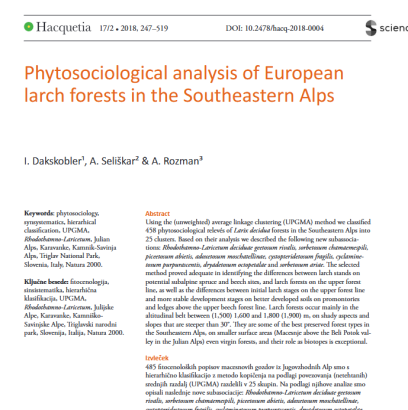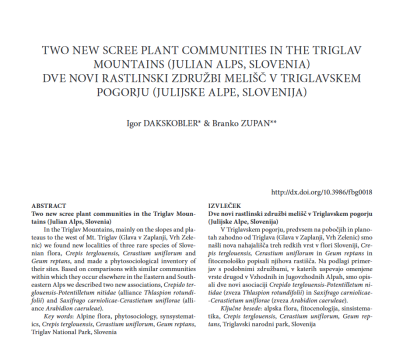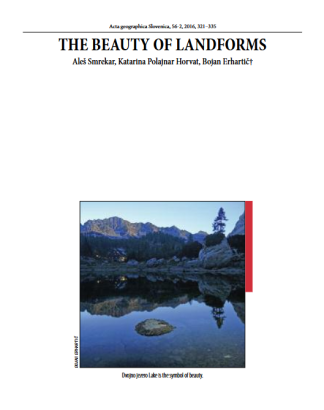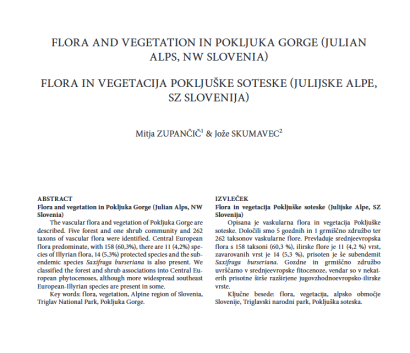Digital library
Showing results 1 - 12/14
The Julian Alps: A Model for Transboundary Conservation and Sustainable Development
The Julian Alps, spanning the border between Slovenia and Italy, are a remarkable example of transboundary cooperation in biodiversity conservation. The interviews and focus group we organized with the main stakeholders in the area allowed the TRANSNATURE consortium to uncover the main characteristics of this transboundary cooperation.
Source
Other
Year
2025
Type
News
Format
Website
Author
Francisco Javier Romero Caro
Keywords
Julian Alps, Biosphere Reserve, transboundary
Območja
Triglav National Park, Alps
Phytosociological analysis of acidophytic alpine mat-grass swards in the Julian Alps and the Karawanks
Acidophytic alpine mat-grass swards are rare in the alpine belt of the predominantly calcareous Southeastern Alps of Slovenia, mostly occurring where limestone is admixed with marlstone or chert. Those for which we were able to make phytosociological relevés can be classified mainly into two syntaxa: Carici curvulae-Nardetum strictae vaccinietosum gaultherioidis and Sieversio-Nardetum
strictae vaccinietosum. At slightly lower elevations, in the forest zone of the subalpine plateau Pokljuka, we found similar swards occupying small areas in frost hollows with luvisol on limestone. They include character species of various subalpine-alpine sward and snow bed communities and are classified into the syntaxon Homogyno alpinae-Nardetum scorzoneroidetosum croceae.
Source
Digitalna knjižnica Slovenije, ZRC SAZU, Biološki inštitut Jovana Hadžija
Year
2022
Type
Thesis
Format
Website
Authors
Igor Dakskober, Boštjan Surina, Tone Weber
Keywords
Alpine vegetation, Caricion curvulae, Nardion strictae, Mangart, Triglav National Park, Slovenia
Območja
Triglav National Park, Alps, Slovenia
Phytosociological description of spring vegetation in the subalpine and alpine belt of the Julian Alps
Plant communities of several moss-rich calcareous water springs in the subalpine and alpine belt of the Julian Alps were phytosociologicaly investigated. Based on the comparison with similar communities in other parts of the Alps we classify them into the new association Saxifrago robustae-Palustrielletum commutati and in to two subassociations: -violetosum biflorae (mostly in the subalpine belt) and -saxifragetosum sedoidis (mostly in the alpine belt). Stands of described community belong to Natura 2000 habitat type Petrifying springs with tufa formation (Cratoneurion). For
now they are mostly not directly threatened by man.
Source
Digitalna knjižnica Slovenije, Slovenska akademija znanosti in umetnosti
Year
2022
Type
Thesis
Format
Website
Authors
Igor Dakskobler, Andrej Martinčič, Andreja Šalamon
Keywords
Vegetation, Cratoneurion, Julian Alps, Triglav National Park, Slovenia, Italy
Območja
Triglav National Park, Alps
Phytosociological analysis of Carex bicolor All. sites in the Julian Alps
We conducted a phytosociological investigation of the sites of Carex bicolor on the only known localities of this species in the Julian Alps, in the upper part of the Triglav Lakes Valley. Carex bicolor was recorded in different alpine communities, most of which belong to the class Scheuchzerio-Caricetea fuscae and order Caricetalia davallianae. We described a new association Caricetum bicolori-frigidae, which is classified into the alliance Caricion atrofusco-saxatilis and is for now the only community of this alliance in Slovenia.
Source
Digitalna knjižnica Slovenije, Slovenska akademija znanosti in umetnosti
Year
2022
Type
Thesis
Format
Website
Authors
Igor Dakskobler, Andrej Martinčič, Andreja Šalamon
Keywords
Vegetation, alpine lake, snow beds, Triglav National Park, Slovenia
Območja
Triglav National Park, Alps
New localities of Adiantum capillus-veneris and Moehringia villosa in the southern Julian Alps
The article describes new localities of two rare species
of conservation importance of Slovenian flora in the southern julian alps (the tolmin-bohinj and Krn Mts.). The stands of the Mediterranean species Adiantum capillus-veneris in Kneška grapa gorge under Mt. Masovnik (Kneške Ravne) at elevations 570–600 m are assigned to the new variant Eucladio-Adiantetum hymenostylietosum recurvirostri var. Astrantia carniolica. Moehringia villosa, an endemic species of european conservation importance, has its north- westernmost locality in its entire distribution range at curk waterfall in the spring area of the Kozjak under Mt. Krnčica,
where it occurs in the stands of the variant Campanulo carnicae-Moehringietum villosae var. Paederota lutea.
Source
Digitalna knjižnica Slovenije, Slovenska akademija znanosti in umetnosti
Year
2021
Type
Original scientific article
Format
Website
Authors
Igor Dakskobler, Andrej Martinčič, Andreja Šalamon
Keywords
Flora, vegetation, Adiantum capillus-veneris, Moehringia villosa, natura 2000, triglav national park, Slovenia
Območja
Triglav National Park, Alps
Vegetation analysis of the subalpine beech forest on the upper forest line in the Julian Alps (NW Slovenia and NW Italy) and in the northern Dinaric Alps
Using hierarchical clustering with unweighted pair-group method with arithmetic mean (UPGMA) we arranged 603 phytosociological relevés of beech forests on the present upper forest line, mainly from the Julian Alps and the Trnovo Forest Plateau (we also included the relevés from the Karawanks and the Kamnik Alps), into 32 clusters. Based on their analysis and comparison with previously
described similar (alti)montane-subalpine beech communities we classified most of the relevés into the association Polysticho lonchitis-Fagetum and its new subassociations ericetosum carneae, cardaminetosum trifoliae, luzuletosum niveae, luzuletosum luzuloidis, calamagrostietosum variae, allietosum victorialis, adoxetosum moschatellinae, stellarietosum nemorum and several new variants. The altitude of the studied stands is predominantly 1400 to 1550 m (the upper line is at 1660 m); they occur at all aspects, frequently on steep and very steep slopes, mainly on
limestone and dolomite limestone, the predominant soil type is rendzina. These stands are species rich (on average 61 species per relevé, altogether more than 500 vascular plants) and have many species in common with the stands of associations Rhododendro hirsuti-Fagetum and Rhodothamno-Laricetum.
Source
Digitalna knjižnica Slovenije, ZRC SAZU, Biološki inštitut Jovana Hadžija
Year
2021
Type
Thesis
Format
Website
Authors
Igor Dakskobler, Andrej Rozman, Andreja Šalamon
Keywords
Phytosociology, synsystematics, hierarchical classification, UPGMA, beech communities, upper forest line, Julian Alps, Trnovo Forest Plateau, Triglav National Park, Natura 2000, Slovenia, Italy
Območja
Triglav National Park, Alps
Plant communities with Carex frigida in the Julian Alps (northwestern Slovenia)
In already known localities in the Julian Alps (Mangart, Malo Polje, Zeleno Jezero, Blehe under Šoštar) and in several new ones (Loška Koritnica, Bavh, Spodnji Lepoč, Mlinarica, Konjska planina, Mali Babanski Skedenj) we inventoried the stands along the subalpine-alpine springs and spring areas where Carex frigida frequently occurs as the predominant vascular plant. We classified them into the following associations: Saxifrago aizoidis-Caricetum ferrugineae,
Caricetum davallianae s. lat., Ranunculo traunfellneri-Paederotetum luteae, Carici frigidae-Petasitetum albi (alliance Adenostylion alliariae) and Palustriello decipientis- Caricetum frigidae (alliance Cratoneurion). The latter two were described as new. Based on comparisons with similar communities along mountain springs
we discussed the most appropriate classification of the latter into higher syntaxonomic units.
Source
Digitalna knjižnica Slovenije, ZRC SAZU, Biološki inštitut Jovana Hadžija
Year
2021
Type
Thesis
Format
Website
Authors
Igor Dakskobler, Andrej Martinčič, Andreja Šalamon
Keywords
Phytosociology, synsystematics, Cystopteridion, Adenostylion alliariae, Cratoneurion, Triglav National Park, Natura 2000, Slovenia
Območja
Triglav National Park, Alps
Snow-bed communities with dominant Salix herbacea in the Julian Alps
In the alpine belt of the Julian Alps (glacial cirque Na Jezerih under Mt. Veliki Rokav, Jarečica, the Mangart Saddle and Prodi under Mt. Mangart as well as Mt. Plešivec in the rock wall of Loška Stena) we studied the phytosociology and ecology of snow-bed vegetation with dominating flowering plants Salix herbacea, Luzula alpinopilosa, Gnaphalium supinum, Soldanella pusilla and Salix retusa, and numerous moss species. Based on the comparison with similar snow-bed communities in the Central, Eastern and Southern Alps we described a new association Salicetum retuso-herbaceae and classified it into the alliance Salicion herbaceae and class Salicetea herbaceae. We determined several successional stages of snow-bed vegetation on mixed calcareous-silicate bedrock that we treat as variants, in two relevés also the initial association Polytrichetum sexangularis.
Source
Digitalna knjižnica Slovenije, ZRC SAZU, Biološki inštitut Jovana Hadžija
Year
2018
Type
Thesis
Format
Website
Authors
Andrej Martinčič, Tone Wraber, Igor Dakskobler, Andreja Šalamon
Keywords
Phytosociology, plant ecology, synsystematics, Salicetea herbaceae, Salicetum retuso-herbaceae, Polytrichetum sexangularis, Julian
Alps, Triglav National Park, Slovenia, Italy
Območja
Triglav National Park, Alps
Phytosociological analysis of European larch forests in the Southeastern Alps
Using the (unweighted) average linkage clustering (UPGMA) method we classified 458 phytosociological relevés of Larix decidua forests in the Southeastern Alps into 25 clusters. Based on their analysis we described the following new subassociations: Rhodothamno-Laricetum deciduae geetosum rivalis, sorbetosum chamaemespili, piceetosum abietis, adoxetosum moschatellinae, cystopteridetosum fragilis, cyclaminetosum purpurascentis, dryadetosum octopetalae and sorbetosum ariae. The selected
method proved adequate in identifying the differences between larch stands on potential subalpine spruce and beech sites, and larch forests on the upper forest line, as well as the differences between initial larch stages on the upper forest line
and more stable development stages on better developed soils on promontories and ledges above the upper beech forest line. Larch forests occur mainly in the altitudinal belt between (1,500) 1,600 and 1,800 (1,900) m, on shady aspects and slopes that are steeper than 30°. They are some of the best preserved forest types in the Southeastern Alps, on smaller surface areas (Macesnje above the Beli Potok valley in the Julian Alps) even virgin forests, and their role as biotopes is exceptional.
Source
Digitalna knjižnica Slovenije, ZRC SAZU, Biološki inštitut Jovana Hadžija
Year
2018
Type
Thesis
Format
Website
Authors
Igor Dakskobler, Andrej Seliškar, Andrej Rozman, Andreja Šalamon
Keywords
Phytosociology, synsystematics, hierarhical classification, UPGMA, Rhodothamno-Laricetum, Julian Alps, Karavanke, Kamnik-Savinja Alps, Triglav National Park, Slovenia, Italy, Natura 2000
Območja
Triglav National Park, Alps, Slovenia
Two new scree plant communities in the Triglav Mountains (Julian Alps, Slovenia)
In the Triglav Mountains, mainly on the slopes and plateaus to the west of Mt. Triglav (Glava v Zaplanji, Vrh Zelenic) we found new localities of three rare species of Slovenian flora, Crepis terglouensis, Cerastium uniflorum and Geum reptans, and made a phytosociological inventory of their sites. Based on comparisons with similar communities within which they occur elsewhere in the Eastern and Southeastern Alps we described two new associations, Crepido terglouensis-Potentilletum nitidae (alliance Thlaspion rotundifolii) and Saxifrago carniolicae-Cerastietum uniflorae (alliance Arabidion caeruleae).
Source
Digitalna knjižnica Slovenije, Slovenska akademija znanosti in umetnosti
Year
2017
Type
Original scientific article
Format
Website
Authors
Igor Dakskobler, Branko Zupan
Keywords
Alpine flora, phytosociology, synsystematics, Crepis terglouensis, Cerastium uniflorum, Geum reptans, Triglav National Park, Slovenia
Območja
Triglav National Park, Alps
The beauty of landforms
This article determines which landforms attract people the most and whether one can speak of collective patterns in the aesthetic evaluation of a landscape. It therefore concerns enjoying the beauty offered by a more or less reshaped natural environment. This study is based on the Triglav Lakes Valley (Dolina Triglavskih jezer) in Slovenia which, due to the few man-made changes introduced there, includes hardly any anthropogenic »unnecessary noise.« The online survey included more than six hundred people and used photos of various landforms. Lakes were found to be the most attractive to the respondents, and fractured rock areas were the least attractive.
Source
Digitalna knjižnica Slovenije, Slovenska akademija znanosti in umetnosti, Založba ZRC
Year
2016
Type
Thesis
Format
Website
Authors
Aleš Smrekar, Katarina Polajnar Horvat, Bojan Erhartič, Manca Volk Bahun
Keywords
Geography, aesthetics, photography, nature, landscape online survey, Dolina Triglavskih jezer, Triglav National Park, Slovenia
Območja
Triglav National Park, Alps
Flora and vegetation in Pokljuka Gorge (Julian Alps, NW Slovenia)
The vascular flora and vegetation of Pokljuka Gorge are described. Five forest and one shrub community and 262 taxons of vascular flora were identified. Central European flora predominate, with 158 (60,3%), there are 11 (4,2%) species of Illyrian flora, 14 (5,3%) protected species and the subendemic species Saxifraga burseriana is also present. We classified the forest and shrub associations into Central European phytocenoses, although more widespread southeast European-Illyrian species are present in some.
Source
Digitalna knjižnica Slovenije, Slovenska akademija znanosti in umetnosti
Year
2015
Type
Thesis
Format
Document (PDF, DOC, ...)
Authors
Mitja Zupančič, Jože Skumavec
Keywords
Flora, vegetation, Alpine region of Slovenia, Triglav National Park, Pokljuka Gorge
Območja
Triglav National Park, Alps

